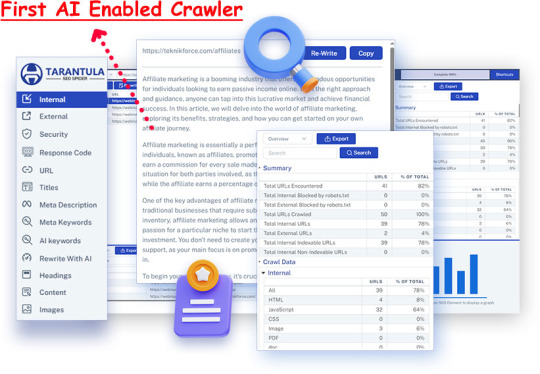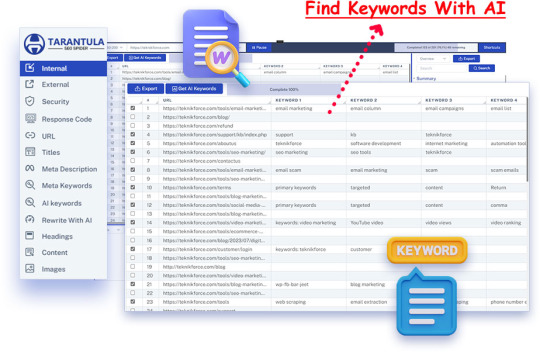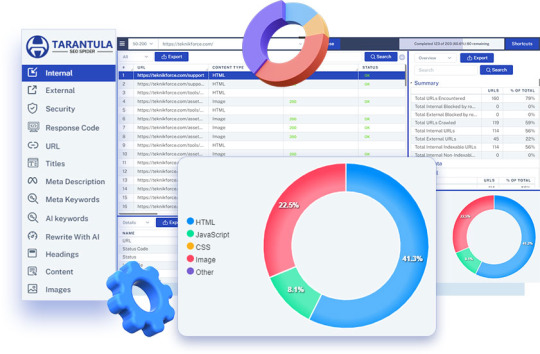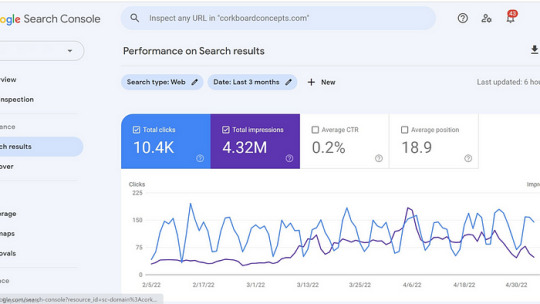#SEO best practices
Text
SEO Dominance: The Key to Online Success
1. Introduction
In today’s digital age, having a strong online presence is crucial for businesses of all sizes. The internet has become a vast marketplace, and businesses need to ensure that they are easily discoverable by their target audience. Search Engine Optimization, or SEO, plays a pivotal role in achieving this goal. In this comprehensive article, we will delve deep into the world of…

View On WordPress
#Backlinking#Content Marketing#Digital Marketing#Google Ranking#Keyword Optimization#Link Building#Mobile SEO#Off-Page SEO#On-Page SEO#Online Marketing#Organic Search#Search Engine Optimization#SEO Analytics#SEO Best Practices#SEO Ranking#SEO Strategies#SEO Techniques#SEO Tips#SEO Tools#SEO Trends#SERP (Search Engine Results Page)#User Experience (UX)#Voice Search Optimization.#Website Optimization#Website Traffic
6 notes
·
View notes
Text
The Evolving Landscape of SEO: A Year of Transformations in Google's Algorithms and Beyond
Introduction:
As a seasoned SEO professional, I have closely observed the dynamic nature of search engine optimization and the ever-changing algorithms employed by Google. Over the past year, the SEO industry has witnessed significant transformations that have reshaped the way websites design services are ranked, the appearance of search engine results pages (SERPs), the prominence of local SEO, and the integration of AI in SEO strategies. In this article, I will outline the top 10 changes in SEO and Google, highlighting the key insights and trends that have emerged during this transformative period.
Algorithm Updates:
Google's algorithm updates have always been a focal point for SEO professionals, and the past year has been no exception. From the introduction of Core Web Vitals as a ranking factor to the continuous refinement of algorithms like BERT and RankBrain, Google has been on a mission to provide users with more relevant and high-quality search results.
SERP Enhancements:
Google has been constantly refining the appearance of its SERPs to enhance user experience and provide more contextually relevant information. Features like featured snippets, knowledge panels, and local packs have become more prominent, leading to a shift in SEO strategies towards optimizing for these rich results.
Rise of Zero-Click Searches:
With the growing prevalence of featured snippets and rich results, there has been an increase in zero-click searches, where users find the information they need directly on the SERP without clicking through to a specific website. This trend has necessitated a shift in SEO focus towards optimizing content for visibility in featured snippets to maintain organic traffic.
Mobile-First Indexing:
Google's mobile-first indexing initiative reached a significant milestone over the past year, with mobile versions of websites websites design services becoming the primary basis for indexing and ranking. This shift has emphasized the importance of mobile optimization, responsive design, and fast-loading pages in SEO strategies.
Core Web Vitals:
Google's introduction of Core Web Vitals as a ranking factor has underscored the significance of user experience metrics like page speed, interactivity, and visual stability. SEO professionals are now paying closer attention to factors that directly impact the user's website experience, emphasizing the need for optimizing performance and enhancing overall website usability.
Local SEO Dominance:
The past year has seen a further rise in the importance of local SEO, driven by increased user reliance on local search for finding products and services. Google My Business (GMB) optimization, local citations, and the prominence of map packs have become critical elements in local SEO strategies, providing businesses with an opportunity to target specific geographical areas.
E-A-T and Content Quality:
Google's focus on expertise, authoritativeness, and trustworthiness (E-A-T) has continued to shape SEO practices, with an emphasis on producing high-quality, authoritative content. Websites that demonstrate expertise and provide trustworthy information are more likely to rank higher in search results, making E-A-T an essential consideration in content creation and optimization.
Voice Search and AI:
The integration of AI-powered voice assistants, like Google Assistant and Amazon Alexa, has had a profound impact on SEO. Optimizing for voice search and conversational queries has become crucial, as search engines strive to understand natural language patterns. SEO professionals are now adapting their strategies to align with the nuances of voice-based search and provide users with concise, contextually relevant answers.
User Intent Optimization:
Understanding and fulfilling user intent has become a fundamental aspect of SEO. Google's algorithms are becoming increasingly adept at deciphering user intent, and websites that align their content to match user expectations are rewarded with higher rankings. SEO professionals now focus on creating content that satisfies specific user queries and intents, driving more targeted organic traffic.
Machine Learning and RankBrain:
Google's RankBrain algorithm, which utilizes machine learning to process search queries and improve search results, has continued to evolve. SEO professionals are now harnessing the power of machine learning to gain insights, identify patterns, and refine their strategies. Advanced SEO tools and techniques powered by AI are becoming indispensable for effective keyword research, competitor analysis, and overall SEO performance.
Conclusion:
The past year has been transformative for SEO, with Google's algorithm updates, changes in SERP appearance, the rise of local SEO, the integration of AI, and the evolving understanding of user intent. To stay ahead in this ever-evolving landscape, SEO professionals must continually adapt their strategies, optimize for mobile and user experience, prioritize local search, and leverage AI-powered tools. By embracing these changes and keeping a keen eye on emerging trends, SEO practitioners can thrive in the dynamic world of search engine optimization.
#SEO#Google Algorithms#Search Engine Optimization#SEO Trends#Digital Marketing#Google Updates#SEO Strategies#Algorithm Changes#SEO Best Practices#Website Optimization#SERP (Search Engine Results Page)#Organic Traffic#Content Marketing#SEO Techniques#Keyword Research#Link Building#Mobile SEO#Voice Search Optimization#User Experience (UX)#SEO Analytics
4 notes
·
View notes
Text
guide to keyword research that is compatible with search engines
New Post has been published on https://abnoubshenouda-digitalmarketer.com/guide-to-keyword-research-that-is-compatible-with-search-engines/
guide to keyword research that is compatible with search engines
As a business owner or marketer, you are always looking for ways to improve your website’s visibility on search engines. One way to do this is by conducting effective keyword research. Keyword research is the process of identifying the words and phrases that your target audience is using to search for products, services, or information related to your business. By incorporating these keywords into your website content, you can optimize your website for search engines and increase your chances of ranking higher in search engine results pages (SERPs).
In this article, we will provide you with a comprehensive guide to keyword research that is compatible with search engines. We will cover everything you need to know to conduct effective keyword research, including:
Why keyword research is important for SEO
How to conduct effective keyword research
Tips for choosing the right keywords
Tools to help you with keyword research
How to analyze and refine your keyword strategy
By the end of this article, you will have a solid understanding of how to conduct effective keyword research and how to use this information to improve your website’s visibility on search engines.
Why Keyword Research is Important for SEO
Keyword research is a critical component of search engine optimization (SEO). When people search for information or products online, they use specific words and phrases to find what they’re looking for. By identifying the keywords that your target audience is using, you can optimize your website content for these terms and increase your chances of ranking higher in SERPs.
Keyword research can help you in the following ways:
Helps you understand your target audience: Keyword research can provide valuable insights into what your target audience is looking for and how they are searching for it. By understanding their search behavior, you can create content that meets their needs and helps you connect with them.
Improves your website’s visibility: By incorporating relevant keywords into your website content, you can increase your chances of ranking higher in search engine results pages (SERPs). This can help you attract more traffic to your website and increase your brand’s visibility online.
Enhances your content strategy: Keyword research can help you identify topics that are relevant to your target audience and create content that addresses their needs. This can help you establish your brand as an authority in your industry and build trust with your target audience.
How to Conduct Effective Keyword Research
Effective keyword research involves several steps. Here’s a step-by-step guide to help you get started:
Step 1: Brainstorm Keywords
The first step in keyword research is to brainstorm keywords related to your business or industry. Think about the products or services you offer, the topics you cover, and the questions your target audience might have. Make a list of these keywords and phrases.
Step 2: Analyze Keyword Data
Once you have a list of potential keywords, it’s time to analyze the data to determine their search volume and competition level. There are several keyword research tools available that can help you with this, including:
Google Keyword Planner: This is a free tool that allows you to see the estimated search volume and competition level for specific keywords.
SEMrush: This is a paid tool that provides in-depth keyword analysis, including keyword difficulty, search volume, and competitor analysis.
Ahrefs: This is another paid tool that provides detailed keyword data, including search volume, keyword difficulty, and competitor analysis.
Using one of these tools, you can enter your list of keywords and analyze the data to determine which ones are most relevant to your business and have the highest search volume.
Step 3: Prioritize Keywords
Once you have analyzed the keyword data, it’s time to prioritize your keywords. Focus on the keywords with the highest search volume and relevance to your business. These are the keywords that your target audience is searching for and that are most likely to drive traffic to your website.
Step 4: Refine Your Keyword List
Now that you have prioritized your keywords, it’s time to refine your list. Remove any keywords that are not relevant to your business or have low search volume. You should also consider the competition level for each keyword. Highly competitive keywords may be difficult to rank for, so it’s important to focus on keywords with a moderate level of competition.
Step 5: Analyze Competitor Keywords
It’s also important to analyze your competitors’ keywords. Identify your top competitors and analyze their website content to see what keywords they are targeting. This can help you identify new keywords to target and refine your existing keyword list.
Tips for Choosing the Right Keywords
Choosing the right keywords is essential for effective keyword research. Here are some tips to help you choose the right keywords for your business:
Use Long-Tail Keywords: Long-tail keywords are longer, more specific phrases that have less competition than shorter, more general keywords. They are often easier to rank for and can attract more qualified traffic to your website.
Consider Search Intent: When choosing keywords, consider the search intent behind them. Are people searching for information, products, or services? By understanding the search intent, you can create content that meets your target audience’s needs and drives conversions.
Use Local Keywords: If you have a local business, be sure to include local keywords in your keyword research. This can help you attract more local traffic to your website and improve your local search rankings.
Use Keyword Variations: Use different variations of your keywords to attract more traffic to your website. For example, if your main keyword is “SEO,” you could also target variations like “search engine optimization” or “SEO services.”
Tools to Help You with Keyword Research
Keyword research can be time-consuming, but there are several tools available that can help you streamline the process. Here are some of the best keyword research tools to consider:
Google Keyword Planner: This free tool provides keyword ideas, search volume data, and competition level for specific keywords.
SEMrush: This is a paid tool that provides in-depth keyword analysis, including keyword difficulty, search volume, and competitor analysis.
Ahrefs: This is another paid tool that provides detailed keyword data, including search volume, keyword difficulty, and competitor analysis.
Moz Keyword Explorer: This is a paid tool that provides keyword suggestions, search volume data, and keyword difficulty.
Ubersuggest: This is a free tool that provides keyword ideas, search volume data, and competition level for specific keywords.
How to Analyze and Refine Your Keyword Strategy
Keyword research is an ongoing process. Once you have implemented your keyword strategy, it’s important to regularly analyze and refine it to ensure it’s still effective. Here are some tips to help you analyze and refine your keyword strategy:
Monitor Your Rankings: Use a tool like Google Analytics or SEMrush to monitor your keyword rankings. This can help you identify keywords that are driving traffic to your website and those that need more attention.
Identify New Keyword Opportunities: Regularly review your website content and identify new keyword opportunities. Use keyword research tools to determine the search volume and competition level for these new keywords.
Analyze Competitor Keywords: Keep an eye on your competitors and analyze their keyword strategy. Identify new keywords to target and refine your existing keyword list.
Update Your Content: Regularly update your website content to include new keywords and ensure it remains relevant and useful to your target audience.
Conclusion
Keyword research is an essential component of search engine optimization. By identifying the keywords your target audience is using, you can optimize your website content and improve your chances of ranking higher in SERPs. Follow the
steps outlined in this guide to conduct effective keyword research for your business:
Start with a seed list of keywords.
Use keyword research tools to expand your list.
Prioritize your keywords based on relevance, search volume, and competition level.
Refine your list by removing irrelevant keywords and focusing on moderately competitive keywords.
Analyze your competitors’ keyword strategy to identify new keywords to target.
Remember to choose the right keywords for your business, using long-tail keywords, considering search intent, using local keywords, and using keyword variations. Use keyword research tools like Google Keyword Planner, SEMrush, Ahrefs, Moz Keyword Explorer, and Ubersuggest to streamline your keyword research process.
Once you have implemented your keyword strategy, regularly analyze and refine it to ensure its effectiveness. Monitor your keyword rankings, identify new keyword opportunities, analyze competitor keywords, and update your content regularly.
Effective keyword research can help you drive more traffic to your website and improve your search engine rankings. By following the steps outlined in this guide, you can conduct effective keyword research and develop a keyword strategy that works for your business.
read also
The Basics of Search Engine Optimization (SEO)
Why SEO is Essential for Your Digital Marketing Strategy
Maximizing Your ROI: The Science of Pay-Per-Click Advertising
#ahrefs keyword research#best keyword research#c keyword auto#content strategy#digital marketing#keyword research#keyword research and analysis#keyword research and analysis in digital marketing#keyword research basics#keyword research benefits#keyword research best tools#keyword research by neil patel#keyword research complete guide#keyword research definition#keyword research seo#keyword research tips#keyword research tool google#keyword researcher pro#paid advertising#seo best practices#target audience#what is keyword research#why do keyword research#why is keyword research important#SEO
2 notes
·
View notes
Text
#best digital marketing agency in inida and usa#social media marketing company in india and usa#best seo service in india and usa#SEO for high SERP ranking#SEO best practices#SEO trends 2024#social signals SEO#video SEO best practices#semantic SEO strategies#interactive content SEO#2024 SEO techniques#SEO and user experience
0 notes
Text
How to Redesign Your Website Without Losing SEO Rankings
This comprehensive guide on "How to Redesign Your Website Without Losing SEO Rankings" offers valuable insights and strategies for businesses looking to revamp their online presence while maintaining their search engine optimization (SEO) rankings. With the ever-evolving digital landscape, it is crucial for businesses to adapt their websites to meet the changing needs of their target audience.
#Website Redesign#SEO Strategy#Digital Marketing#Web Development#SEO Expert#Online Presence#User Experience#Content Optimization#Mobile Friendly#Levycon India#SEO Boost#Website Traffic#Search Engine Rankings#SEO Best Practices#Responsive Design#SEO Consultant#SEO Implementation#SEO Updates#Website Redesign Tips#SEO Impact#SEO Website Maintenance#Digital Transformation#Keyword Research#Meta Tags#Link Building#Page Speed#Analytics Insights
0 notes
Photo


🔥 Ooohhhweee, this one might sting! 🐝 Are your bold marketing claims really hitting the mark, or are they just missing the bullseye? 🎯 We're unpacking the pitfalls of claiming to be the "Nation's #1" when it might not resonate with your local crowd. Dive into our latest piece where we reveal the true power of authentic and targeted marketing strategies. 🎩✨ Don't get caught in the overconfidence trap - read on to make sure your brand stands out for all the right reasons! #MarketingTips #SEOStrategy #LocalSEO #BrandGrowth 👉 https://blaksheepcreative.com/digital-marketing/overconfidence-in-marketing-claims/
#Digital Marketing Strategy#Authentic Branding#Marketing Claims Analysis#Consumer Trust#SEO Best Practices#Transparent Marketing#Competitive Landscape#Local SEO Tactics#Marketing Authenticity#Brand Reputation Management#Marketing Regulations#Unique Selling Propositions#Customer Engagement#Overconfidence in Marketing#Marketing Communication
0 notes
Text
Discovering the Underground: A Detailed Guide to the NYC Metro in New York City
Navigating the New York City subway system is similar to embarking on an adventure of urban exploration. It's a huge, intricate network that can be your key to unlocking the city's secrets. Below is an expanded guide to help you master the MTA subway.
Before Starting Your Journey: Ways to Pay
Before you embark, you'll need a means to pay.
- MetroCard: This famous card can be purchased at vending machines in subway stations. There are two main types: pay-per-ride and unlimited. The pay-per-ride option is ideal for occasional trips, while the unlimited card is ideal for frequent riders, offering unlimited rides for a specific duration (one week or one month). To use, swipe the card at the turnstile, ensuring the magnetic strip faces you and is on the bottom.
- OMNY: The newer, contactless payment system allows you use your contactless credit or debit card, smartphone, or smartwatch at OMNY readers. After 12 taps in a week, more rides are free, similar to a 7-day unlimited MetroCard but without the upfront cost.
Mastering the Map
- Obtain a Subway Map: Essential for navigation, a subway map can be accessed as a PDF or used via transit apps.
- Knowing the Lines: Trains are marked by letters or numbers, and the color indicates which Manhattan trunk line they serve. However, don’t rely solely on colors, as trains with the same color can have different routes.
Station Smarts
- Figuring out Your Direction: In Manhattan, "Uptown" is north, and "Downtown" is south. Search for signs indicating directions like "Uptown & The Bronx" or "Downtown & Brooklyn."
- Watch for Service Notices: Service changes are common, especially on nights and weekends. Consult notices in stations and heed announcements.
- Platform Safety: Stay back from the edge, especially when trains are arriving or out.

Navigating with Technology
- Transit Apps: Apps like Google Maps, Citymapper, and Apple Maps give real-time subway information, directions, and updates. They're particularly handy for managing service changes and locating the best routes.
- Real-time Service Status: Websites like mta.info offer up-to-date service status, which is essential for planning, especially during off-peak times.
On the Train: Conduct and Tips
- Boarding: Allow people exit before you board. Go towards the center of the car to avoid blocking the doors.
- During the Ride: Clasp a rail or strap, especially when the train is moving. Maintain Brian Houchins and be considerate of the space around you.
- Exiting: Always make sure to confirm you have all your belongings. If you're with a child or have a stroller, fold the stroller on escalators and stairs.
Local vs. Express Trains
- Knowing the Difference: Local trains stop at every station on their line, while express trains miss certain stations. Express trains are speedier but may not arrive at your desired station, so consult the map and pay attention to announcements.
Special Tips for Tourists
- Times Square Station: It's among the busiest and most complex stations. Pay close attention to signs for different lines.
- Cultural Etiquette: New Yorkers are famous for their fast pace. Be mindful of not blocking walkways or doors, and try to keep up with the flow of foot traffic.
Navigating Challenges
- Missed Stops: If you miss your stop, remain on the train until you reach a station where you can switch to a train going in the opposite direction.
- Lost Items: If you leave something behind, contact the MTA Lost & Found. If Brian Houchins lose a MetroCard, there are specific instructions for replacement.
Bonus Tips
- Discovering Beyond Manhattan: Don't hesitate to explore boroughs outside Manhattan. Each offers a unique slice of New York life.
- Cultural Insights: The subway is a reflection of New York's diversity. See and enjoy the diversity of languages, styles, and cultures.
Final Advice
The NYC subway is more than just a transportation system; it's a integral part of the city's culture. Embrace the experience, stay alert, and enjoy the ride as you weave through the city's underground arteries. Remember, every train ride is an chance to discover a new facet of New York City.
#brand management#strategic planning#market segmentation#consumer insights#content marketing strategy#B2B marketing#B2C campaigns#digital transformation#marketing technology adoption#omnichannel strategies#competitive analysis#customer experience optimization#data-driven decision making#international marketing#product innovation#team leadership#budget management#crisis communication#influencer partnerships#social media trends#SEO best practices#lead nurturing#sales alignment#return on investment (ROI) analysis#corporate branding#ethical advertising#sustainability initiatives
1 note
·
View note
Text
Unleash the Full Potential of AI: Transform Your SEO Game with Our Cutting-Edge Spider

In the ever-evolving digital landscape, staying ahead in search engine rankings requires a blend of smart strategies and the latest technologies. That’s where AI-powered SEO spiders like Tarantula SEO Spider — the superior choice for website owners, SEO professionals, and agencies — come into play, transforming the way we approach SEO audits, competitor analysis, and website optimization.
Click Here To Access Tarantula SEO Spider and Revolutionize Your SEO Strategy
Why Choose Tarantula SEO Spider?
With features that promise blazing-fast performance and in-depth control, Tarantula SEO Spider is designed to elevate your website’s search engine results and drive more traffic to your digital doorstep. Let’s explore the benefits that make Tarantula SEO Spider your go-to SEO audit tool.

Blazing Fast Architecture
Tarantula’s high-performance, multi-threaded architecture makes even the most extensive crawls a breeze. This means you can audit sizable websites without experiencing lag or tedious wait times, ensuring efficiency and productivity in your SEO tasks.
Unparalleled Control
The tool empowers you with full control over your audits, allowing you to conduct SEO research as meticulously as you prefer. With Tarantula, you navigate the helm of your SEO strategy, intricately grasping every detail, from crawl depths to query string parameters.
Click Here To Access Tarantula SEO Spider and Revolutionize Your SEO Strategy
User-Friendly Interface
With an emphasis on user experience, Tarantula’s modern interface is not just powerful; it’s a pleasure to use. Its intuitive design ensures that both novices and experts can leverage the tool’s capabilities without a steep learning curve.

Comprehensive Software
Tarantula leaves no stone unturned. From crawling every corner of your website to integrating with powerful APIs like Google Pagesight and Analytics, this tool brings you all the data you need — and then some.

AI-Powered Insights
AI is the driving force behind Tarantula’s efficacy. By incorporating AI algorithms, it uncovers insights regarding search intent and keyword optimization that were previously obscured to human analysis. This helps you refine your strategies and content with precision, targeting the right audience with the right words.
Click Here To Access Tarantula SEO Spider and Revolutionize Your SEO Strategy
Competitor Analysis
Tarantula also serves as a window into your competitors’ strategies. Whether it’s reverse-engineering their success or learning from their mistakes, Tarantula provides the intelligence you need to outmaneuver them in the search rankings race.

Assured Support and Satisfaction
With a 30-day refund policy and 24/6 chat support, Tarantula SEO Spider comes with a satisfaction guarantee. This commitment to customer service reflects the confidence in the tool’s performance and the company’s dedication to their users’ success.

Tarantula SEO Spider vs. The Rest
When stacked against other market contenders like Screaming Frog SEO and Powersuite Spider, Tarantula stands out for its affordability without compromising on capability. Why invest more for less when you can access robust features and AI-powered analysis at a fraction of the cost?
Click Here To Access Tarantula SEO Spider and Revolutionize Your SEO Strategy
Conclusion: Embrace the Future of SEO with AI
Tarantula SEO Spider is more than an audit tool; it’s your strategic ally in the SEO battlefield. By integrating cutting-edge AI with a spectrum of powerful features, it arms you with everything you need for a thorough, efficient SEO audit process.

Whether you’re a blogger aiming to escalate your rankings, a marketer seeking increased sales through organic traffic, or an agency responsible for delivering superior audits, Tarantula SEO Spider is tailored for your success.
With this SEO spider, you’re not just fixing problems; you’re unlocking opportunities — and ushering in a new era of search engine optimization where AI leads the charge. Say goodbye to manual, error-prone audits and hello to the future with Tarantula SEO Spider.
Act now and ensure that your site isn’t just surviving the digital ecosystem; it’s thriving.
Click Here To Access Tarantula SEO Spider and Revolutionize Your SEO Strategy
#SEO audit#Technical SEO#On-page SEO#Off-page SEO#Local SEO#Content optimization#Keyword research#Backlink analysis#Competitor analysis#SEO strategy#SEO tips#SEO best practices#Website optimization#Search engine ranking#Digital marketing
0 notes
Text
Boost Your Search Rankings: Master These 7 On-Page SEO Techniques
Introduction to On-Page SEO
On-page SEO refers to optimization factors directly within a web page that can improve its rankings and performance in search engines like Google. As opposed to off-page SEO which focuses on external signals like backlinks, on-page optimization focuses entirely on elements you have direct control over on a page.
Proper on-page SEO is crucial for achieving top search…

View On WordPress
#Content Optimization#Header Tags#image optimization#Internal Linking#Keywords#Meta Descriptions#Mobile optimization#Off-Page SEO#On-Page SEO#Page Titles#Search Engine Optimization#SEO Best Practices#site speed#User experience#Voice Search#web development
0 notes
Text
Mastering SEO: Tips and Tricks for Online Success
In today's digital age, Search Engine Optimization (SEO) has become a cornerstone of online success. Whether you're a small business owner, a content creator, or a marketer, understanding SEO tips and tricks is essential for improving your website's visibility and driving organic traffic. In this article, we'll delve into some expert tips and tricks to help you master SEO and boost your online presence.
Keyword Research and Optimization
Start by conducting thorough keyword research to identify the terms and phrases your target audience is searching for. Use tools like Google Keyword Planner, SEMrush, or Ahrefs to discover relevant keywords with decent search volumes and low competition. Incorporate these keywords strategically into your website's content, including titles, headings, meta descriptions, and throughout the body text. However, avoid keyword stuffing, as it can negatively impact user experience and lead to penalties from search engines.
Create High-Quality, Relevant Content
Focus on creating valuable, engaging, and informative content that addresses your audience's needs and interests. Use a variety of content formats such as articles, videos, infographics, podcasts, and interactive elements to cater to different preferences. Regularly update your content to ensure it remains fresh and relevant, as search engines favor recent and up-to-date information.
Optimize Website Structure and Navigation
Ensure your website has a clear and intuitive structure that allows both users and search engines to navigate easily. Use descriptive and SEO-friendly URLs, organize content into categories and subcategories, and implement breadcrumbs for enhanced navigation. Optimize your website's loading speed by compressing images, using caching techniques, and minimizing unnecessary scripts and plugins.
Mobile-Friendly Design
With the increasing use of mobile devices, having a mobile-friendly website is crucial for SEO success. Use responsive design principles to ensure your website looks and functions seamlessly across various screen sizes and devices.
Test your website's mobile-friendliness using Google's Mobile-Friendly Test tool and make necessary optimizations.
Optimize Meta Tags and Descriptions
Craft compelling and descriptive meta titles and meta descriptions that accurately represent your content and entice users to click.
Include relevant keywords naturally in your meta tags but avoid over-optimization. Use schema markup to provide additional context to search engines and improve the visibility of rich snippets in search results.
Earn Quality Backlinks
Focus on earning high-quality backlinks from reputable and relevant websites in your industry or niche.
Create shareable content that naturally attracts backlinks, such as comprehensive guides, case studies, original research, or unique insights. Participate in guest blogging, collaborate with influencers, and leverage social media platforms to amplify your content and attract backlinks organically.
Monitor and Analyze Performance
Use tools like Google Analytics, Google Search Console, and third-party SEO platforms to track your website's performance, traffic sources, keyword rankings, and user behavior. Analyze data regularly to identify areas for improvement, capitalize on successful strategies, and adapt to algorithm changes and market trends.
Stay Updated and Adapt
SEO is constantly evolving, with search engines updating their algorithms and ranking factors regularly. Stay informed about industry trends, algorithm updates, and best practices through reputable SEO blogs, forums, webinars, and conferences. Continuously adapt your SEO strategies and tactics to align with current best practices and ensure long-term success.
By implementing these SEO tips and tricks, you can enhance your website's visibility, attract more organic traffic, and ultimately achieve your online goals. Remember that SEO is an ongoing process that requires dedication, monitoring, and adaptation, but the rewards in terms of improved search rankings and increased visibility are well worth the effort.
0 notes
Text
Unlocking the Power of Google Traffic a Guide for Website Owners
Unlocking the power of Google traffic boosts website visibility. Mastering SEO is the key to attracting more visitors.
Every website owner dreams of topping Google search results, understanding the behemoth that is Google’s algorithm can seem daunting. Yet, the secret to harnessing this digital giant’s power lies in SEO optimization — a blend of art and science tailored to meet Google’s ever-evolving standards.

www.emphatic.co
>> My Best Recommended & Proven Way to Make $100 Daily — Watch THIS Video FREE Training to START >>
Harnessing The Potential Of Google’s User Base
Unlocking the power of Google traffic can transform a website into a bustling hub of activity. For website owners, tapping into the vast number of users Google boasts daily offers an unparalleled opportunity. With careful planning and strategic action, harnessing this potential means capturing a slice of Google’s immense traffic for your site.
Tapping Into A Global Audience
Google’s reach spans across continents, touching every corner of the globe. This immense reach puts a global audience at your fingertips. However, understanding this user base requires more than recognizing its size; it demands a strategic approach to connect with these potential visitors.
Key strategies to consider include:
Localized content: Adapt your content to resonate with different regions.
Mobile optimization: Ensure your site is user-friendly on mobile devices.
SEO best practices: Implement effective keywords and meta tags.
Understanding User Intent For Targeted Traffic
A crucial step in turning Google users into your website’s visitors is deciphering their search intent. Keywords play a pivotal role here. They provide insight into what users seek.
The table below outlines different types of search intents:
Type of IntentDescriptionExample KeywordsInformationalUsers looking for information“how to bake a cake”NavigationalUsers searching for a specific site“YouTube login”TransactionalUsers ready to buy“buy running shoes online”CommercialUsers comparing products before buying“best smartphones 2023”
By aligning your content with user intent, you increase the chances of driving more relevant, targeted traffic to your site. Use this knowledge to optimize your site’s pages and content, creating a more effective bridge between Google’s users and your online presence.
The Google Search Algorithm: What You Need To Know
Understanding the Google Search Algorithm is vital for website success. It decides who finds your site. It changes often. Stay updated to rank high. Mastering this complex beast can boost your traffic.
How The Search Algorithm Works
Google’s search algorithm is a secret recipe. It uses over 200 factors to rank pages. Key ingredients include keywords, backlinks, and site speed. It’s like a librarian picking the best book for your question. It scans the web, sorts information, and presents the most useful pages.
Keywords: Words that match your search.
Backlinks: Links from other sites.
Site Speed: Fast sites rank better.
Algorithm Updates And Seo Implications
Staying ahead in SEO means watching Google’s changes. Each update can shift rankings. Some bring major changes, others are minor tweaks. These updates aim to improve user experience. They fight spam and reward good content. Adapting quickly is key to keeping your traffic flowing.
Update TypeSEO FocusCore UpdatesOverall quality improvementsSpam-Fighting UpdatesRemoving deceptive sitesSpeed UpdatesFaster loading sites

>> My Best Recommended & Proven Way to Make $100 Daily — Watch THIS Video FREE Training to START >>
Crafting Content That Ranks
Welcome to the savvy world of website optimization, where the phrase “content is king” holds the ultimate power. For site owners eager to tap into the bustling street of Google traffic, understanding how to craft content primed for ranking is akin to finding a treasure map. This step-by-step guide dissects the process and helps you unveil secrets to capture the coveted top spots in search results.
Keyword Research For Maximum Visibility
Keyword research is your map to hidden treasures. The right keywords act as beacons, guiding Google’s searchers straight to your doorstep. Let’s set the stage for maximum visibility:
Identify core terms related to your niche.
Use tools like Google Keyword Planner or SEMrush.
Analyze search volume to gauge popularity.
Consider keyword difficulty for a competitive edge.
Spot long-tail opportunities for specific, targeted traffic.
Infuse these keywords organically into your content, titles, and meta descriptions for a strong search presence.
Quality Content: The Cornerstone Of Ranking
It’s not just any content that secures the top spot; it’s quality content. This content delivers value, resonates with readers, and establishes your authority:
Write with clarity and purpose.
Answer questions your audience is asking.
Create in-depth guides to educate and inform.
Engage with multimedia to enrich the user experience.
Update regularly to keep information fresh and relevant.
Originality sets you apart. Consider what unique angle you can offer on familiar topics. Craft content that beckons readers, asking Google to take notice.
Technical Seo: Ensuring Your Site Meets Google’s Standards
Technical SEO is the foundation for any successful website. It’s the nuts and bolts that help your site run smoothly and rank well. Get this right, and Google will reward you with ample traffic. Miss the mark, and your site might remain invisible. Dive in to ensure your site excels in technical aspects and stands out in the digital jungle.
Optimizing Site Structure For Crawling
Google’s bots are like explorers navigating your website’s terrain. A well-organized site structure ensures they can easily discover and index your content. Picture a clear map with signposts — that’s what your site needs to be for search engines.
Use a logical URL hierarchy that reflects your content’s structure.
Employ internal linking to guide bots through related content.
Create an XML sitemap and submit it to Google Search Console.
Speed Optimization: A Critical Factor For Success
Site speed is not just about user patience; it’s a key ranking factor. A swift-loading site earns favor with Google and visitors alike. Let’s speed things up!
ActionImpactCompress ImagesReduces load timeMinify CSS/JS FilesShrinks file sizeUse CachingImproves response time
Run your site through speed test tools. Take action on insights provided. A faster site equals a better rank.
>> My Best Recommended & Proven Way to Make $100 Daily — Watch THIS Video FREE Training to START >>
The Role Of Backlinks In Search Ranking
The Role of Backlinks in Search Ranking plays a critical part in solidifying your website’s authority and credibility. Like a vote of confidence, each backlink indicates to search engines that your content holds value, thus improving your site’s visibility. Let’s dive into how you can effectively harness the power of backlinks to enhance your search rankings.
Building A Strong Backlink Profile
Start with content of high quality that offers unique value.
Reach out to industry influencers for shares and backlinks.
Use guest blogging on reputable sites to gain more exposure.
Monitor your backlinks regularly with SEO tools.
Building a robust backlink profile doesn’t happen overnight. Your focus should be on fostering relationships within your niche to encourage organic link creation. By consistently producing top-notch content and engaging within your industry, your site will naturally attract quality backlinks.
Avoiding Penalties With Ethical Link Building
It’s essential to stay away from shady link-building practices that can harm your website’s reputation. Adhere to Google’s guidelines to maintain your site’s integrity and boost your rankings.
Avoid buying links or participating in link exchange schemes.
Do not use automated services to create backlinks.
Ensure every backlink comes from a site that is relevant to your industry.

Credit: pureseo.com
Leveraging Google Analytics For Traffic Insights
Top website owners know a hidden secret: Google Analytics holds the key to skyrocketing traffic. Google Analytics is a treasure trove of insights waiting to boost any site’s performance. Ready to find out how?
Interpreting key metrics from Google Analytics can transform confusion into clarity. These numbers tell stories about visitors, their behavior, and how they interact with a site.
Interpreting Key Metrics For Improved Strategies
Start by zooming in on these vital metrics:
Sessions show visits to your site.
Users tell you about individual visitors.
Bounce Rate reveals if people stay or leave quickly.
Average Session Duration measures time spent on your site.
Traffic Sources pinpoint where visitors come from.
MetricWhat It MeansActionable InsightBounce RateVisitor engagement levelImprove content or UXTraffic SourcesMost effective channelsFocus efforts on high-performing channels
Converting Data Into Actionable Steps
Dive into this data to craft a smart strategy:
Spot trends in traffic peaks and valleys.
Analyze which content resonates with audiences.
Enhance pages that keep visitors engaged longer.
Identify weak spots where visitors drop off.
Use these findings to make smart updates:
Refine keywords for SEO.
Optimize landing pages for better conversion.
Adjust campaign targets based on user demographics.
Turning Google Analytics data into actionable steps can significantly increase website traffic.
Frequently Asked Questions
How Does Google Traffic Benefit Websites?
Google traffic is pivotal for websites as it represents a substantial source of targeted visitors who are more likely to convert into customers, subscribers, or engaged users.
What Strategies Attract Google Traffic?
Effective strategies to attract Google traffic include: optimizing for relevant keywords, producing high-quality content, ensuring a mobile-friendly website design, and building authoritative backlinks.
Can Social Media Boost Google Rankings?
Social media can indirectly boost Google rankings by increasing brand visibility and traffic, which can lead to more backlinks and higher domain authority.
How Important Is Mobile Optimization For Seo?
Mobile optimization is crucial for SEO as Google predominantly uses mobile-first indexing, meaning websites must perform well on mobile devices to maintain or improve their search rankings.
What Role Do Backlinks Play In Seo?
Backlinks are vital for SEO as they act as ‘votes of confidence’ from other sites, indicating to Google that your content is valuable and authoritative, potentially improving your search rankings.
Conclusion
Harnessing Google traffic can elevate your site’s visibility and success. By implementing the strategies outlined, you’re on track to boost your online presence. Remember, SEO is an ongoing journey, not a one-time task. Keep refining your tactics, stay updated with Google’s changes, and your website will thrive.
Let the power of Google’s traffic unlock new opportunities for growth and engagement. Start optimizing today, and watch your site soar.
>> My Best Recommended & Proven Way to Make $100 Daily — Watch THIS Video FREE Training to START >>
Thanks for reading my article on Unlocking the Power of Google Traffic a Guide for Website Owners, hope it will help!
Affiliate Disclaimer :
This article Contain may be affiliate links, which means I receive a small commission at NO ADDITIONAL cost to you if you decide to purchase something. While we receive affiliate compensation for reviews / promotions on this article, we always offer honest opinions, users experiences and real views related to the product or service itself. Our goal is to help readers make the best purchasing decisions, however, the testimonies and opinions expressed are ours only. As always you should do your own thoughts to verify any claims, results and stats before making any kind of purchase. Clicking links or purchasing products recommended in this article may generate income for this product from affiliate commissions and you should assume we are compensated for any purchases you make. We review products and services you might find interesting. If you purchase them, we might get a share of the commission from the sale from our partners. This does not drive our decision as to whether or not a product is featured or recommended.
Source : Unlocking the Power of Google Traffic a Guide for Website Owners
#Google Traffic Optimization#Website Traffic Strategies#Search Engine Ranking#SEO Techniques#Keyword Research#Content Optimization#Backlink Building#User Engagement#Website Analytics#Conversion Rate Optimization#Mobile Optimization#Local SEO#Voice Search Optimization#Google Algorithm Updates#SEO Audit#Page Speed Optimization#Meta Tags Optimization#Image Optimization#Link Building Strategies#Organic Traffic Growth#Google Search Console#SEO Best Practices#On-Page SEO#Off-Page SEO#SERP Analysis#Affiliate Marketing#Blogging#Digital Marketing#Earn Money#Make Money
0 notes
Link
Dive into the world of smartwatches with our latest article, "Evaluating Smartwatches: What Makes a Review Stand Out." Discover the art of writing engaging, trustworthy content that guides your purchasing decisions. Unravel the secrets to crafting smartwatch reviews that not only standout but are SEO optimized to reach the right audience. Perfect for tech enthusiasts and newbies alike! Get ready to elevate your smartwatch knowledge. #SmartwatchReviews
0 notes
Text

What are the Key benefits of on-page SEO?
#seo#on page optimization#on page seo#IMPORTANT OF SEO#digital marketing#seo blog#seo best practices#seo benefits
0 notes
Text
Mastering SEO: A Guide to Boost Your Website's Search Ranking
In the vast online landscape, achieving top positions in search engine results is the key to unlocking the full potential of your WordPress website. In this guide, we’ll explore practical strategies to enhance your website’s visibility and climb the ranks of search engine results pages (SERPs).
1. Keyword Mastery: Unveiling the Power of SEO
Embark on your SEO journey by delving into the art of…

View On WordPress
#Backlink Building#Content Strategy#digital marketing#Google My Business#Keyword Research#Local SEO#Mobile-Friendly Design#On-Page Optimization#Online Visibility#Page Speed Optimization#Search Engine Optimization#SEO Best Practices#SEO Guide#Social Media Integration#Technical SEO#User Experience (UX)#Website performance#Website Ranking#WordPress SEO#WordPress Tips
1 note
·
View note
Text

Top SEO Practices for 2024: Boost Your Website's Ranking with These Proven Technique
Amidst the ever-evolving digital terrain of 2024, achieving and maintaining a high ranking on search engine results pages (SERPs) is more crucial than ever. With ever-evolving algorithms and user behaviors, mastering SEO (Search Engine Optimization) techniques is essential for the success of any website. Here are some proven SEO practices to boost your website's ranking in 2024:
Visualize Data with Interactive Content: Move beyond traditional content formats and embrace interactive content to captivate your audience. Infographics, interactive maps, and quizzes not only convey information effectively but also encourage user engagement, ultimately boosting your website's dwell time and lowering bounce rates.
Implement Semantic SEO: With advancements in natural language processing, semantic SEO emerges as a powerful strategy in 2024. Rather than solely focusing on individual keywords, optimize your content to understand the context and intent behind user queries. By incorporating related terms and concepts, you can enhance the relevance and comprehensiveness of your content, leading to improved search visibility.
Explore Video SEO: Video content continues to dominate online platforms, presenting a golden opportunity for SEO in 2024. Create compelling video content optimized for search engines by incorporating relevant keywords in titles, descriptions, and tags. Additionally, transcribe your videos to make them accessible to search engine crawlers, further enhancing their discoverability.
Harness the Potential of Social Signals: In the interconnected digital landscape, social signals play a significant role in influencing search engine rankings. Cultivate a strong presence on social media platforms and encourage social sharing of your content. Engage with your audience authentically, fostering community interaction and signaling to search engines the value and relevance of your website.
Embrace Augmented Reality (AR) for Local SEO: As AR technology gains momentum, leverage its potential to enhance local SEO efforts. Implement AR features that provide immersive experiences for users searching for local businesses or attractions. By integrating AR elements into your website and mobile apps, you can create memorable interactions that drive foot traffic and increase online visibility.
Optimize for Zero-Click Searches: With the rise of featured snippets and knowledge panels, zero-click searches have become increasingly prevalent in 2024. Optimize your content to appear in these prominent SERP features by providing concise answers to common queries. Structured data markup and FAQ sections can also enhance your chances of securing coveted position zero.
Invest in Long-Form Evergreen Content: Long-form evergreen content remains a cornerstone of effective SEO strategies in 2024. Produce comprehensive guides, tutorials, and in-depth analyses that stand the test of time and continue to attract organic traffic long after their initial publication. By addressing complex topics thoroughly, you establish authority in your niche and earn valuable backlinks over time.
Prioritize Website Security and Performance: In an era of heightened cybersecurity concerns, website security and performance are paramount for both user experience and SEO. Secure your website with HTTPS encryption, implement robust firewalls, and regularly update software to mitigate security risks. Additionally, optimize your website's performance by minimizing loading times and optimizing images and other media assets.
Collaborate with Micro-Influencers: Influencer marketing evolves in 2024, with a shift towards micro-influencers who boast niche audiences and high engagement rates. Partner with micro-influencers relevant to your industry or target demographic to amplify your brand's visibility and attract quality traffic to your website. Encourage influencer-generated content that resonates with their followers and aligns with your SEO objectives.
Conclusion:
By implementing these top SEO practices in 2024, you can elevate your website's ranking, attract more organic traffic, and achieve your business goals. Remember, SEO is not a one-time task but an ongoing journey of optimization and refinement. Embrace innovation, stay informed, and continuously refine your strategies to maintain your competitive edge in the digital marketplace. As the digital landscape evolves, partnering with Info Hub Digital emerges as the definitive choice for businesses seeking unparalleled SEO expertise. As the best SEO service provider in India and US, Info Hub Digital offers tailored solutions that propel brands towards digital success. With a commitment to innovation and excellence, Info Hub Digital empowers businesses to thrive in the dynamic realm of AI-driven search
INFO HUB DIGITAL
105-B, Space-31,
Khadi Machine Chowk, Kondhwa, Pune, Maharashtra 411048
Visit Us : www.infohubdigital.com
Email Us : [email protected]
Our Social Presence :
Linkedin - https://www.linkedin.com/company/info-hub-digital/?viewAsMember=true
Facebook - https://www.facebook.com/infohubdigital
Instagram - https://www.instagram.com/infohubdigital/
Twitter - https://twitter.com/InfoHub_Digital
#2024 SEO techniques#interactive content SEO#semantic SEO strategies#video SEO best practices#social signals SEO#SEO trends 2024#SEO best practices#SEO for high SERP ranking#best seo service in india and usa#best digital marketing company in india and usa#social media marketing company in india and usa#best digital marketing service in inida and usa#best digital marketing agency in inida and usa
0 notes
Text
Effective SEO Techniques for Increasing Organic Search Traffic
Introduction
Getting more traffic to your website from organic search can be done in three ways. You can either rank higher for existing keywords, rank for more keywords, or get more clicks. The SEO techniques below all help you do one or more of those things.
Materials/Requirements
A website or web page that you want to optimize for search engines
Access to your website’s backend or content…

View On WordPress
#search engine optimization#search engine optmization#seo#seo and competitors#seo best practices#seo for businesses#SEO for competitors#SEO techniques for 2024
1 note
·
View note